
|   |

|   |
 e-mail: ukb7@rediffmail.com A triptych of femininity May 5, 2021 Sharmila Biswas, the acclaimed Odissi dancer of the eastern metropolis, has produced an engrossing study of the woman's psyche in her latest dance production. This is a portraiture of the feminine mood reimagining three stock approaches from Indian literature. The first is from a social viewpoint of a mother, who lets loose her offspring into the future, by gradually cutting the apron strings binding them together. The second one is a royal model where the Patta Mahishi (the reigning empress) has to fall back on her baffling situation with her trusted husband foisting a new consort on the royal household, unannounced and unsolicited. The third one is a mythic woman who has been a quintessential lover all her life and is simply unable to come to terms with the permanent separation of her mon amour. Antaranga Festival, the online show organized on April 23 by Sangeet Natak Akademi, featured the three highly innovative items of Sharmila over around 46 minutes. Another fascinating aspect was their being placed in three time horizons; future, present and past, in the reverse order. In the first item, the mother has inevitably cut her "umbilical cord" as the narrative says and she pushes her progeny into an unknown and uncertain future, where the child would have to look after herself amidst all the turmoil and forebodings, and without any familial protection. In the second, all the royal grandeur and recognition notwithstanding, the queen has to face an ugly present in an existential situation making space in her conjugal bed for another woman foisted on her. In the third, the lovelorn Radha is hopelessly immersed in the past memories and only hopes - without hope - that her Krishna returns to re-live the idyllic past! 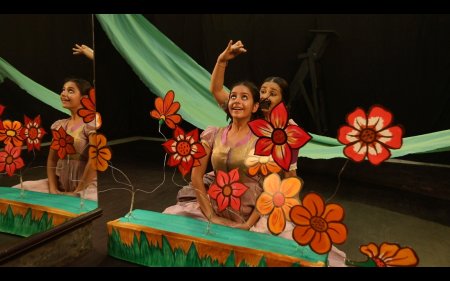
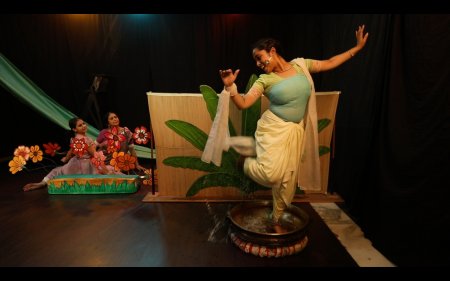
And Sharmila takes upon herself to don all the three roles and does a brilliant job of them. The setting all through is provided in an interview format between Sharmila and the art critic Kathakali Jana and filmed adroitly by Neelay Sengupta. Departure, the first presentation, starts on a frolicsome note, with a Scottish ditty Ye banks and braes... by Robert Burns, providing inspiration for a young Tagore at 21, to follow with an undulating tune to compose Amidst the flowers in the bowers, beside the flowing river..., and with teenage dancers (Rohini, Debottama, Tanushree, Raagini and others) from Sharmila's OVM group providing the traipsing around the eager, yet fading mother. There are brilliant camera shots and mix-and-match of images to a distant echo of a few notes from the raga Malkauns. The accent is uniformly on jovial conviviality creating the milieu for a faintly painful breaking loose coming up soon... 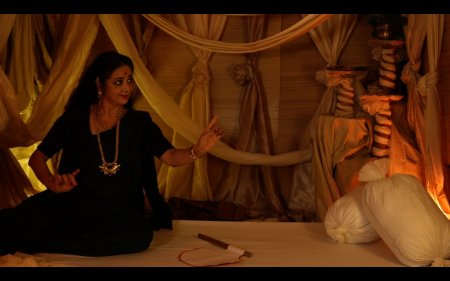

In contrast, Upeksha (the Ignoring) is on the musical note of shehnai playing the raga Maru Behag and the empress Draupadi from Mahabharat - with her back to the camera - creating through her eloquent monologue the near-suffocating situation of having to lose her hold on the brave and faithful Arjuna and having to listen to the praise from her mother-in-law about the new bride Subhadra -- whom Arjuna has brought in after an exile of twelve years- to be installed on the conjugal bed, her unquestionable prerogative so far. In expressive hastabhinaya, she imagines being eased into the new insufferable situation of installing Subhadra there and smilingly accepting the unquestionable ignominy.... The musical interplay of shehnai with Maru Behag and the voice of Debolina Sarkar's Sargam on raga Marwa - by just interchanging a few notes - is very well modulated in creating point-counterpoint, with Sharmila now doing full frontal mukhabinaya alongside her hastamudras. Srijan Chatterjee's new creation in Swaramalika has been well derived from Bijay Jana's original Swaramalika. 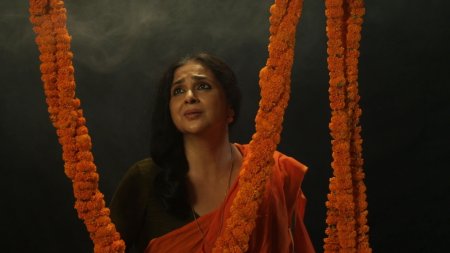
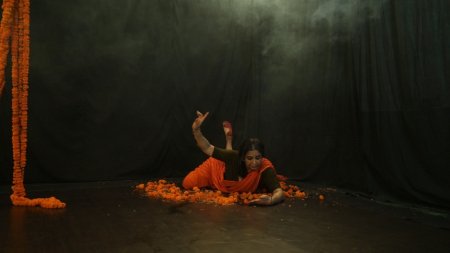
Apeksha (the Waiting), the grand finale, is attempted at yet another plane by Sharmila getting into the psyche of a near-deranged Radha. Sitting in front of a giant garland hanging aloft, it is almost entirely pantomime of a very high order of a distraught Radha: walking down her memory lane, lost in thoughts that interplay on her face, now disbelieving, now confident that her lover would be back. After all, she has sent many letters through the river Yamuna, many messages through the parrots, scribbled many thoughts on the floor and wiped them out!The music inter-alia uses an Odissi raga, Shoka Bharali, playing hauntingly the iterative refrain: Pa-ma-ga-re-sa / re-ga-ma-dha-sa / re-ga-ma-ga-re-re-sa...Srijan Chatterjee, Bijay Jana and Debolina Sarkar continue to hold the musical fort. To a bemused Radha, the marigold garland alternates for a swing on which the lover duo had swung many times in spring not so long ago... Extracts from an interview with the director-choreographer: How do you relate your themes and treatment to the current uneasy times? The current situation itself has motivated me to conceive and create these dances. "Dis-union" is the sthai bhava in all the three dances. In Departure - mother holding the invisible umbilical cord, when daughter moves away. In Upeksha - the distance which grows between a man and a woman in love, because of the entry of another person. Though they have apparent physical proximity, there is this gap. Our current virtual world. In Apeksha - obsessive thoughts to connect with someone who will never come back. All of us are coping with these dis-unions, personally. Does this typology of women's psyche selected by you represent modern woman's responses in any way? Frankly, I see a timelessness in all the characters and their responses, mythological / historical / modern. All respond in the same manner, the social backdrops makes them seem different. A mother feels the same pang of separation, a rejected lover feels the same disappointment, and a person whose near and dear one has died will always be in a delusion, not really accepting the fact. How did you choose your music? For me, music is always simple, but the execution has to match each emotion / movement of the dance.The music for Departure was composed, while I watched the Rabindra Sangeet exponent Pubali Debnath working with teenager Nikhita Gandhi (now a well-known singer in Bollywood). They were working on the song Phulephule... The lovely bonding they developed, while I watched, helped me to create rest of the music. That was 15 years back, and it was used to show expressions of a particular tala. But the essence remained. I used the same music without any change. The swaramalika used in Upeksha is in raga Hangsanarayani / Marwa. It has a beautiful bittersweet quality, which I found appropriate as Draupadi's voice. Shehnai was an obvious choice, no other instrument can bring an instant mood of celebration /ceremony. What decided your choice of colours for the costumes? The choice of colours in costumes and other props come automatically, from the theme itself. In Departure it is pastel shades of spring. In Upeksha, it is heavy dark and regal colours of Draupadi as the queen in distress. It also looks good with the cream and white backdrop. In Apeksha it is the vivid saffron and orange to depict so many things related to Radha. The colours for the first one were chosen by me, the second and third ones by Neelay Sengupta, our film director and set designer, my student. Finally, will your format remain the same for proscenium presentation? Actually, all three have been originally composed for stage. A few changes were made for filming. On the stage the format will remain the same, with more stylization.  Dr. Utpal K Banerjee is a scholar-commentator on performing arts over last four decades. He has authored 23 books on Indian art and culture, and 10 on Tagore studies. He served IGNCA as National Project Director, was a Tagore Research Scholar and is recipient of Padma Shri. Post your comments Pl provide your name and email id along with your comment. All appropriate comments posted with name and email id in the blog will also be featured in the site. |